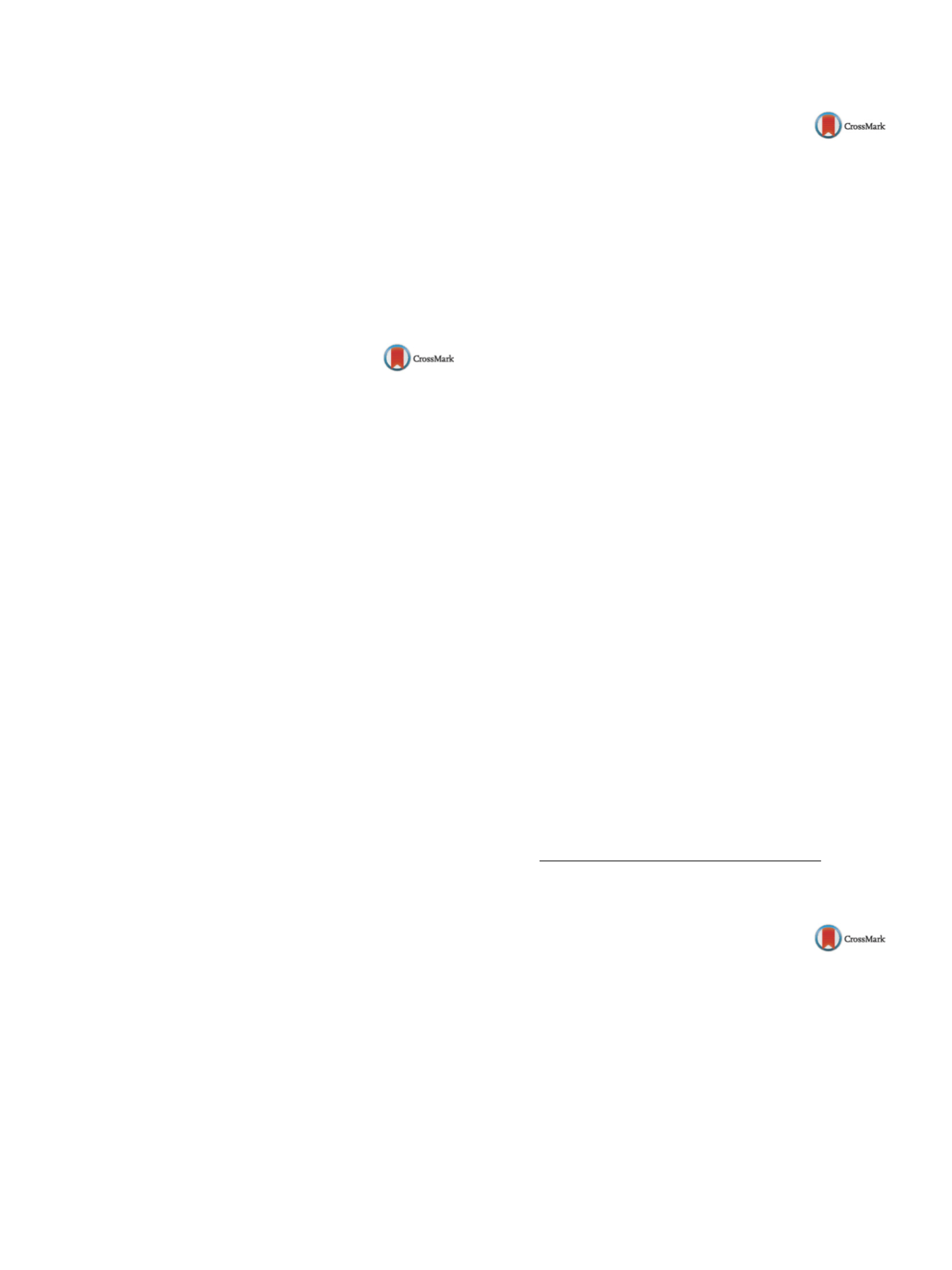

S366
25th European congress of psychiatry / European Psychiatry 41S (2017) S365–S404
CUMS groups, respectively. In immunohistochemical experiments,
Iba-1 was overexpressed in CUMS group and BBG significantly
reduced the overexpression of Iba-1.
Conclusion
Our results suggest that chronic administration of
BBG has an antidepressant-like activity supporting the notion
of P2X7 receptors involvement in depression by modulating
microglial activation.
This research was supported by grant from Marmara University,
Scientific Research Projects – SAG-C-YLP-110915-0416 and SAG-
E-120613-0233.
Disclosure of interest
The authors have not supplied their decla-
ration of competing interest.
http://dx.doi.org/10.1016/j.eurpsy.2017.02.367EW0754
Harmane suppresses microglial
neuroinflammatory response and
induce antidepressant-like effect in
rats
F. Aricioglu
1 ,∗
, G. Arkan
1, C. Kandemir
2, S. Sirvanci
2,
C. Ozkartal
1, T. Utkan
31
Marmara University School of Pharmacy, Department of
Pharmacology and Psychopharmacology Research Unit, Istanbul,
Turkey
2
Marmara University School of Medicine, Department of Histology
Embriology, Istanbul, Turkey
3
Kocaeli University School of Medicine, Department of
Pharmacology, Kocaeli, Turkey
∗
Corresponding author.
Objective
Harmane is a beta-carboline, which binds to imida-
zoline receptors and it has been previously shown that it may
have an antidepressant effect when administered acutely. This
study is planned to investigate the effect of harmane on chronic
unpredictable mild stress (CUMS) model and microglial (Iba-1)
immunoreactivity in the same model as markers of neuroinflam-
mation.
Methods
Male Wistar Albino rats (290–360 g) were divided
into groups such as control (saline), CUMS, CUMS + Imipra-
mine (20mg/kg; i.p.), CUMS +Harmane5 (5mg/kg; i.p.),
CUMS +Harmane10 (10mg/kg; i.p.) groups (
n
= 10–12 in each). In
CUMS model, various stressors were applied for 40 days. On day
20, harmane administration was started for 20 days. At the end,
sucrose preference and forced swimming tests were performed.
Then, brains were removed with paraformaldehyde perfusion for
Iba-1 immunohistochemical analysis in hippocampus. One-way
analysis of variance and Tukey’s test were used for statistical
analysis.
Results
The time of immobility in forced swim test was sig-
nificantly reduced while sucrose preference was increased in
Imipramine and CUMS + harmane10 groups. In immunohistochem-
ical experiments, Iba-1 were overexpressed in CUMS group and
Harmane significantly reduced the overexpression of Iba-1.
Conclusion
Our results suggest that chronic administration of
harmane has an antidepressant-like activity in chronic stressmodel
of depression. These results support the notion of imidazoline
receptors involvement in depression by modulating neuroinflam-
mation and at least a part of its antidepressant effect might be
through modulating microglial activation as a reflection of neu-
roinflammation.
This research was supported by Marmara University, Scientific
Research Projects – SAG-C-YLP-110915-0415 and SAG-E-120613-
0233.
Disclosure of interest
The authors have not supplied their decla-
ration of competing interest.
http://dx.doi.org/10.1016/j.eurpsy.2017.02.368EW0755
Investigation of chemical interactions
of small peptides and vitamin
substances at the developed
dopamine D2 receptor models
R. Aslancan
1 ,∗
, B. Aksoydan
2, I. Kantarcioglu
2, I. Erol
3,
R.E. Salmas
2, S. Durdagi
21
Bahcesehir University, School of Medicine, Istanbul, Turkey
2
Bahcesehir University, Department of Biophysics, School of
Medicine, Istanbul, Turkey
3
Gebze Technical University, Department of Chemistry, Kocaeli,
Turkey
∗
Corresponding author.
Introduction
Dopamine receptors perform various functions
essential to vertebrate central nervous systems and they are the
major targets of antipsychotic drugs. Our recent studies pioneered
to performmolecular modeling studies of the dopamine D2 recep-
tor (D2R), describing the mechanism and binding affinities of
marketed antipsychotics into the active sites of the D2
high
R and
D2
Low
R
[1] . Another study provided significant information about
changes of binding cavity properties of D2R
[2] .Objectives
Since the marketed antipsychotics have serious side
effects, we aim to explore ligands with better inhibition profiles
on D2R with less unwanted outcomes. For this aim, we compare
the effectiveness of the marketed drugs with small peptides and
vitamin substances.
Aims
The main goal of the research is to explore novel small
molecules that inhibit D2R to be used in schizophrenia.
Methods
In this study, we used a large number of endogen vita-
mins and peptides with dopamine D2R active-inactive forms in
monomeric-dimeric patterns to understand their interactions at
the active sites of targets. Nineteen of antipsychotic drugs, which
are widely used in schizophrenia treatment are selected as ref-
erence molecules. Molecular docking, molecular screening and
molecular modeling approaches were used.
Results
Some of these endogen molecules showed similar or bet-
ter inhibition profiles on D2R compared to the known standard
inhibitors of the target.
Conclusions
Proposed molecules may be potent for D2 receptor
inhibition with less side effects for the use for schizophrenia.
Disclosure of interest
The authors have not supplied their decla-
ration of competing interest.
References
[1] Durdagi S, Salmas RE, Stein M, Yurtsever M, Seeman P. ACS
Chem. Neuroscience 2016.
[2] Ekhteiari Salmas R, Yurtsever M, Stein M, Durdagi S. Mol Divers
2015,
http://dx.doi.org/10.1007/s11030-015-9569-3 . http://dx.doi.org/10.1016/j.eurpsy.2017.02.369EW0756
Pharmacodynamic targets of
psychotic patients treated with
a long-acting therapy
A. Ventriglio
1, A. Petito
1, A. Gentile
1, G. Vitrani
1, I. Bonfitto
1 ,∗
,
A.C. Cecere
1, A. Rinaldi
1, C. Dimatteo
2, G. D’Andrea
2,
M. Maurizio
2, A. Bellomo
11
University of Foggia, Department of Mental Health ASL-FG, Foggia,
Italy
2
University of Foggia, Department of Genetics, OO, RR, Foggia, Italy
∗
Corresponding author.
Introduction
Given the poor compliance of schizofrenic patients
to antipsychotic therapies, are been developed drugs in long-acting
formulation that for their pharmacokinetic ensures prolonged ther-
apeutic activities. Currently, we consider that their efficacy depends
on hereditary tracts, influencing both pharmacodynamic and phar-
macokinetic parameters.


















